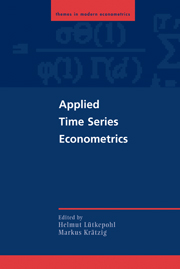Book contents
- Frontmatter
- Contents
- Preface
- Notation and Abbreviations
- List of Contributors
- 1 Initial Tasks and Overview
- 2 Univariate Time Series Analysis
- 3 Vector Autoregressive and Vector Error Correction Models
- 4 Structural Vector Autoregressive Modeling and Impulse Responses
- 5 Conditional Heteroskedasticity
- 6 Smooth Transition Regression Modeling
- 7 Nonparametric Time Series Modeling
- 8 The Software JMu⌉Ti
- References
- Index
7 - Nonparametric Time Series Modeling
Published online by Cambridge University Press: 23 November 2009
- Frontmatter
- Contents
- Preface
- Notation and Abbreviations
- List of Contributors
- 1 Initial Tasks and Overview
- 2 Univariate Time Series Analysis
- 3 Vector Autoregressive and Vector Error Correction Models
- 4 Structural Vector Autoregressive Modeling and Impulse Responses
- 5 Conditional Heteroskedasticity
- 6 Smooth Transition Regression Modeling
- 7 Nonparametric Time Series Modeling
- 8 The Software JMu⌉Ti
- References
- Index
Summary
Introduction
As the previous chapters have shown, parametric time series modeling offers a great wealth of modeling tools. Linear time series models are generally the starting point for modeling both univariate and multivariate time series data. Such data may also exhibit nonstationary behavior caused by the presence of unit roots, structural breaks, seasonal influences, and the like. If one is interested in nonlinear dynamics, it is no longer sufficient to consider linear models. This situation arises if, for example, the strength of economic relationships depends on the state of the business cycle or if the adjustment speed toward long-run equilibrium relationships is not proportional to the deviation from the long-run equilibrium. Chapter 6 discusses how to build nonlinear parametric models for various kinds of nonlinear dynamics, including those of business cycles. There it is also explained how the parameter estimates can be used to understand the underlying nonlinear dynamic behavior.
However, nonlinear parametric modeling also has its drawbacks. Most importantly, it requires an a priori choice of parametric function classes for the function of interest. The framework of smooth transition regression models discussed in Chapter 6, for example, is widely used. Although it is an appropriate modeling framework for many empirical problems, it may not always capture features that are relevant to the investigator. In the latter case, one has to choose alternative nonlinear parametric models like neural networks or Markov-switching models to name a few. Thus, nonlinear parametric modeling implies the difficult choice of a model class.
In contrast,when using the nonparametric modeling approach, one can avoid this choice.
Information
- Type
- Chapter
- Information
- Applied Time Series Econometrics , pp. 243 - 288Publisher: Cambridge University PressPrint publication year: 2004
Accessibility standard: Unknown
Why this information is here
This section outlines the accessibility features of this content - including support for screen readers, full keyboard navigation and high-contrast display options. This may not be relevant for you.Accessibility Information
- 1
- Cited by
